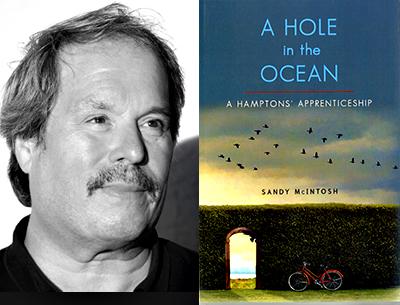When the Lit Life Was Easy

“A Hole in the Ocean”
Sandy McIntosh
Marsh Hawk Press, $16
Stars-in-the-eyes young poet meets literary and art world icons in the Hamptons. And re-meets and reconsiders. And admires. And continues to honor and to create his own work.
Sandy McIntosh graduated from Southampton College — then Long Island University — in 1970. And along the way to his degree he had a number of encounters with artists and writers. Driving on Springs-Fireplace Road he happened upon Willem de Kooning. Well, he didn’t exactly happen upon the artist. Mr. McIntosh was driving home after his job pumping gas when a bicyclist veered here and there then tumbled over. Mr. McIntosh stopped and ran over to see a rather dazed de Kooning lying in the grass. The artist asked for a ride home — his bicycle didn’t have a light.
He was living in a farmhouse opposite the Green River Cemetery, he said, but this was only temporary, until they finished building his new studio. “I don’t want them to finish the damn thing,” he said with some bitterness. I asked why not. “Because when it’s finished, I think I will be finished, too.”
We drove on for a few minutes until he told me to stop. “I live right here,” he said. He looked in the direction of the cemetery and pointed: “All my friends are buried over there.”
Mr. McIntosh dropped off de Kooning and his bike and crossed the road to explore Green River, finding the markers for A.J. Liebling, Frank O’Hara, Stuart Davis, and of course Jackson Pollock’s boulder, and proceeded to ponder.
“A Hole in the Ocean” feels very much like the “Hamptons’ Apprenticeship” of its subtitle, with its aha moments and stories of meetings with and musings about the famous and infamous on the East End. Mr. McIntosh notes that Southampton College has long been a magnet for a number of accomplished people. In the late ’60s people such as the performance poet and scholar Charles Matz and the poet David Ignatow, among others, clustered there.
“How had this group coalesced? According to de Kooning, ‘We’re here in the winter all alone. We work in our studios all day and some of us want to get together at night, usually at Bobby Van’s, or some other bar. Then some people get into fights — Jim Jones likes to throw punches — or get drunk and there is trouble with the police. It’s either that or we meet at the college and talk without getting into too much trouble.’ ”
Near the end of this slim volume Mr. McIntosh turns his thoughts back to Green River. “I reflected on my encounter with de Kooning years before, and had the sobering thought that in subsequent summers a tipsy artist wobbling on his bicycle on a Hamptons road would have little chance of surviving the tourist traffic, which is grim, relentless, and unforgiving. In fact, I realized that the easy access I had in my time to the wonderful artists and writers living there may no longer be possible. These days they all seem to remain cloistered in their compounds, their public appearances protected by bodyguards.”
He goes on to quote part of a poem by Harvey Shapiro:
When we were young,
and our children were young —
the water was such a mystery,
the sky so blue. Everything
breathed promise. The language
would blaze forth,
did blaze forth . . .
To the rich vacationers
our lives meant nothing.
We kept investing them with meaning
until the enterprise broke us . . .
Despite these bittersweet moments, Mr. McIntosh writes with great affection for contemporaries of his, such as the painter John MacWhinnie, as well as about the impact various art institutions, including Guild Hall, have had on the East End arts scene, and about his gratitude to the Hamptons.
There is a deliciously droll tale in the section “One of Many Random Encounters With Truman Capote.” Mr. McIntosh had stopped in Bobby Van’s to sell advertising for his summer newspaper job. Capote was at his corner table.
He recognized me from previous chance meetings and lifted his arm laconically to wave me over. “You must try one of these cocktails,” he said. “You see how lovely and pink mine is, like the Sargasso Sea? Sit down!”
I sat. “What’s in it?”
“Grapefruit juice with just a little splash of vodka. I enjoy one of these — only one — each day.” He waved to the waiter. “Bring this young man one of these.”
“No, thanks,” I said. “I’m working today.”
“Pity. Always working. Well,” he said to the waiter, “you can bring me his. Can’t let this young man’s drink waste away untasted.”
In another vignette, Mr. McIntosh describes the East End literary publication The Bonacker, founded by H.R. Hays in 1953, which published well into the ’60s and featured works by Frank O’Hara, Fairfield Porter, Jeffrey Potter, and John Hall Wheelock. Once the elderly Wheelock asked the young man what he thought about his work, which Mr. McIntosh had found to be “out-of-date poesy.”
“ ‘Don’t feel bad,’ [Wheelock] interrupted my silence. ‘I suspect you’re uneasy with the style of the poems. But you’ll miss something important if you judge the past by the present.’ ”
Wheelock then quotes T.S. Eliot. “Someone said: ‘The dead writers are remote from us because we know so much more than they did.’ Precisely, and they are that which we know.”
Laura Wells is a regular book reviewer for The Star. She lives in Sag Harbor.
Sandy McIntosh headed up the H.R. Hays Distinguished Poets series at Guild Hall from 1980 to 2000.
